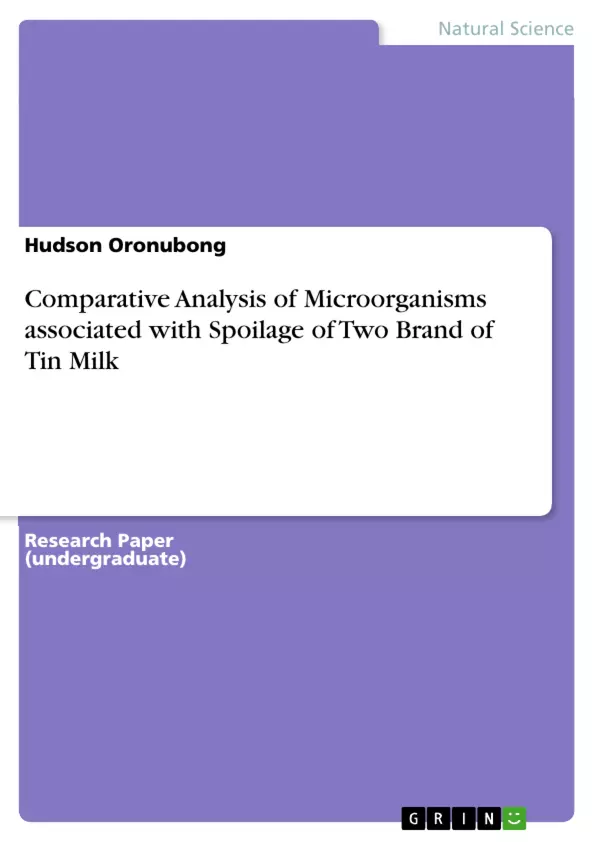Comparative analysis of microorganisms associated with two brand of spoiled tin milk was carried out using standard microbiological techniques. The study revealed that sample A recorded the highest count (4.6 x 106cfu/ml), while sample B recorded the least count of (1.2 x 106cfu/ml) for bacterial and fungal count indicated highest count (1.3 x 106cfu/ml) from sample A, while sample B recorded the least count of (0.5 x 106cfu/ml). The study revealed the presence of five (5) bacterial isolates to include Lactobacillus sp, Pseudomonas sp, Campylobacter sp, Bacillus sp, Staphylococcus sp and four (4) fungal isolates to include Fusarium sp, Aspergillus sp, Penicillium sp and Sacharomyces sp. Lactobacillus sp recorded the highest frequency and percentage occurrence of 16 (27.6%), Pseudomonas sp 13(22.4%), Bacillus sp 12(20.7%), Staphylococcus sp 10(17.2%) while Campylobacter sp had 7(12.1%) as least for bacteria, Aspergillus sp recorded the highest frequency and percentage occurrence of 8(40%), Penicillium sp 6(30%), Fusarium sp, 4(20%), while Sacharomyces sp had 2(10%) as least for fungi.
Inhaltsverzeichnis (Table of Contents)
- COMPARATIVE ANALYSIS OF MICROORGANISMS ASSOCIATED WITH SPOILAGE OF TWO BRAND OF TIN MILK
- ABSTRACT
- INTRODUCTION
- MATERIALS AND METHODS
- Sample Collection
- Microbiological Analysis of spoiled tin milk samples
- RESULTS AND DISCUSSION
- Results
Zielsetzung und Themenschwerpunkte (Objectives and Key Themes)
This study aims to assess the microbial load and identify the associated microorganisms present in two brands of spoiled tin milk. The objective is to understand the potential health risks associated with consuming spoiled milk and highlight the importance of proper storage and handling practices.
- Microbial Contamination in Milk
- Spoilage Microorganisms in Tin Milk
- Health Risks Associated with Spoiled Milk
- Importance of Pasteurization and Proper Milk Handling
- Microbiological Analysis of Spoiled Milk Products
Zusammenfassung der Kapitel (Chapter Summaries)
- COMPARATIVE ANALYSIS OF MICROORGANISMS ASSOCIATED WITH SPOILAGE OF TWO BRAND OF TIN MILK: This chapter provides an introduction to the study and outlines the objectives and methodology. The chapter emphasizes the importance of milk as a food source and discusses the susceptibility of milk to spoilage by microorganisms.
- ABSTRACT: This section summarizes the key findings of the study, highlighting the types and quantities of bacteria and fungi found in the two brands of spoiled tin milk.
- INTRODUCTION: This chapter delves deeper into the topic of milk spoilage, outlining the sources of microbial contamination in milk and the potential health risks associated with consuming contaminated milk.
- MATERIALS AND METHODS: This chapter details the materials and methods used in the study, including the collection of milk samples, preparation of culture media, and the microbiological analysis techniques employed.
- Sample Collection: This section describes the process of collecting and transporting the two brands of tin milk samples to the laboratory for analysis.
- Microbiological Analysis of spoiled tin milk samples: This section explains the steps involved in the microbiological analysis of the spoiled milk samples, including serial dilution, inoculation, incubation, and identification of bacteria and fungi.
- RESULTS AND DISCUSSION: This chapter presents the results of the microbiological analysis and discusses the findings. It includes tables summarizing the total bacterial and fungal counts, as well as tables identifying the types of microorganisms present in the spoiled milk samples.
Schlüsselwörter (Keywords)
This study focuses on the microbiological analysis of spoiled tin milk, investigating the types and quantities of bacteria and fungi present in two brands of milk. The research highlights the importance of proper milk handling, pasteurization, and consumer awareness to minimize the risk of foodborne illnesses.
- Quote paper
- Hudson Oronubong (Author), 2023, Comparative Analysis of Microorganisms associated with Spoilage of Two Brand of Tin Milk, Munich, GRIN Verlag, https://www.hausarbeiten.de/document/1383841


